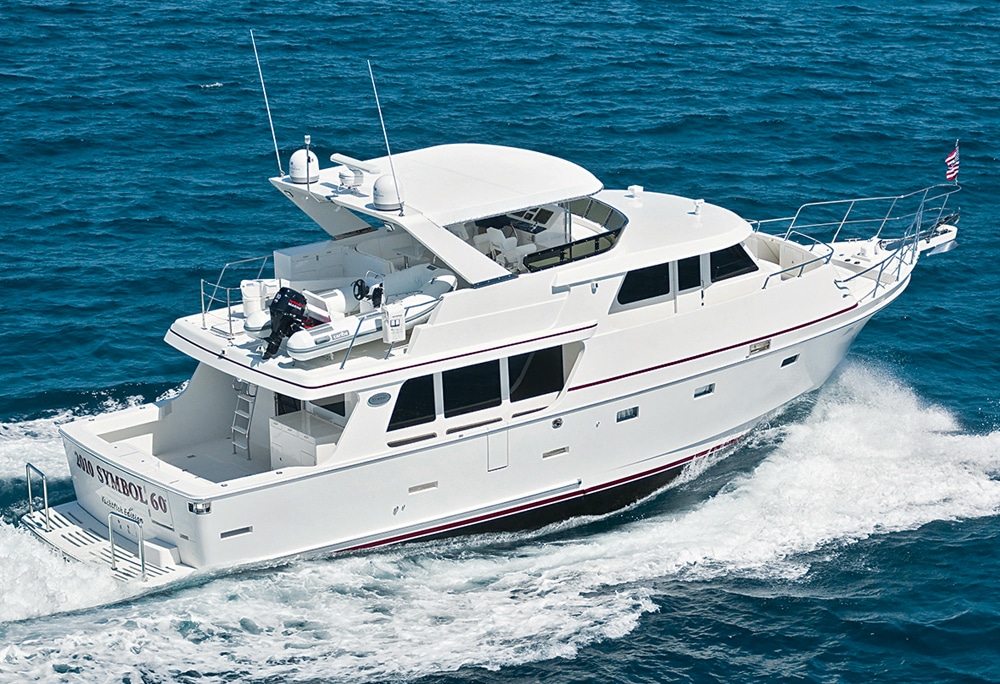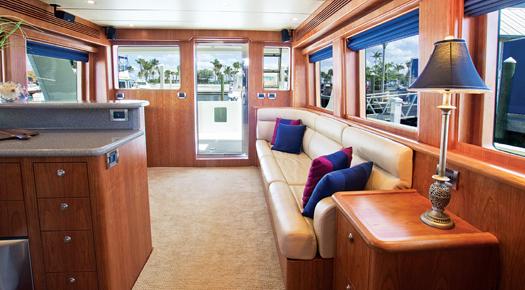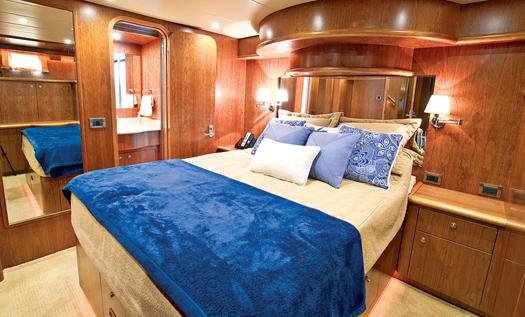
Symbol 60
There is a growing niche market for luxury pickup trucks, like the Cadillac Escalade EXT or the Lincoln Mark LT, which seems hard to comprehend at first. We all know that you’re never going to pile a bunch of tree cuttings in that oh-soexpensive pickup bed, and you’re certainly not going to have those roughnecks at the local lumberyard shovel a few cubic yards of gravel onto that highly polished paint. And there’s no way a bunch of construction workers in filthy work boots will get to sprawl across the soft leather seats.
No, those tasks are better suited to a bare-bones Ford F-150 with vinyl seats and paint that is already dinged and chipped.
So why do people want these luxury pickups? Because (and, please, don’t try to interpret this as sexist) she wants to sit up front in luxury, and he wants a place to easily carry that antique rocking chair they found at a garage sale.
And that’s exactly the reason for the Symbol 60 Yachtfish.
The forward area of the 60 is all luxurious yacht. The back porch is rough-and-tumble sportfishing turf. And, like those uber-luxe pickups, it’s a combination that will work perfectly for many people.
Symbol has built a line of yachtfishers for several years, but considerably larger and (from a sportfishing viewpoint) less nimble. The 60 Yachtfish was conceived by the team of Captain Chris Hall and Jason Nasiatka of Symbol Yachts of Florida who, like the designers at General Motors and Lincoln Mercury, saw a need. Says Hall, a dyed-in-the-wool sportfishing guy whose last personal yacht was a Bertram 46, “We wanted to create a yacht that was versatile enough to carry four guys on a long weekend of fishing just as easily as it could take the whole family on a vacation cruise.” So the Symbol 60 Yachtfish is destined to serve two masters.
How does it fare? Magnificently on all counts. It isn’t as fast as many 60-foot convertibles, but it’s going to get you offshore very comfortably and without pounding your fillings loose, too. On the other hand, the gourmet chef of the family is going to find the galley fit for Cordon Bleu cuisine. And when it comes to tucking in for the night, that master stateroom has all the comforts of a four-star suite. Also, pardon me for being crass up front, but this is a whole lot of yacht considering a base price of about $1.3 million.
Since 1998, Jack Sarin has been the exclusive designer for Symbol Yachts, and he worked closely with Hall and Nasiatka on the 60 Yachtfish.
The starting point for the 60YF was the well-proven Symbol 55 Classic hull, which was stretched by the addition of the fishing cockpit. Besides creating a cockpit to rival many sportfishing battlewagons, it created an immense lazarette for storing all the junk that we add to our boats, and it also gives the yacht a leaner, more purposeful look.
The cockpit is going to please the serious fisherman, because the coamings have been widened and padded for comfort, and a 32-gallon livewell is in the transom, complete with lights and macerator pump. There is a solidly hinged transom door, and dual fishboxes in the cockpit sole. A console against the cabin has a fully equipped tackle station with sink. On our test boat, the cockpit had an aggressive nonslip surface but, having seen a teak cockpit on another Symbol, I think I’d opt for the teak underfoot.
The fishing side of the Yachtfish doesn’t end with just the cockpit, because serious fishermen want, as they say, a lot of sticks in their quiver, so there has to be stowage for rods. And stowage there is in spades. The sofa in the saloon has dedicated rod racks underneath, as does the settee in the pilothouse, and there is also vertical rod space under the inside stairs to the bridge.

For the 60, Hall and Nasiatka specified the galley on the saloon level, although it could also be raised to become part of the pilothouse. I like this arrangement, however, because it creates a pleasant flow to the saloon. There is a breakfast counter on the after side, and the full-sized Sub-Zero refrigerator/freezer/ice maker is against the forward bulkhead. Corian counters wrap around on three sides, inset with a three-burner cooktop and a double stainless steel sink under the large window.
The saloon is straightforward, with a settee to port, a pop-up TV to starboard, and space for a couple of loose chairs. The standard teak interior was upgraded on this yacht to a warm cherry, giving it a bright and airy ambiance.
The pilothouse level is, like the rest of the yacht, an interesting blend of seaworthiness and luxury. The skipper has a Pompanette helm chair on centerline, facing a raised instrument panel with a full array of electronics. Our test boat had Side-Power bow and stern thrusters (bow is standard).
With a fore-and-aft settee next to the helm and an L-shaped settee to port, there’s plenty of seating for everyone. Diamond SeaGlaze watertight sliding doors give easy access to the side decks for short-handing.
Stairs from the pilothouse lead down to a foyer with a hidden washer/dryer, and the master stateroom spans the full beam aft with a centerline queen-size berth. A wraparound bureau with builtin vanity solves the stowage problems with a combination of drawers and lockers, while two hanging lockers add flexibility. The en suite head is to starboard, with a comfortably large shower and Raritan electric head.
The forward cabin features an unusual layout with a V-berth below a pair of upper berths. Some might prefer the standard double berth, but this layout provides more sleeping space for fishermen or kids, and a filler cushion can turn it into a large berth for a couple. There is a private head with shower, opposite the third cabin with two bunks.

Stairs from the pilothouse lead through another watertight door to the flying bridge, where I liked the choice of the two Pompanette helm chairs because they have traditional ladder-back styling. These are both comfortable and a pleasant change from the usual “dental” chairs.
What I found most interesting, however, was the custom laced soft-top over a beautifully executed steel frame. Like the chairs, there’s something retro about the look, and it works beautifully. The skipper gets a full set of navigation and communication electronics that match the lower helm.
Ergonomically, the L-shaped settee is very comfortable with good back support, and a console aft holds a sink and barbecue grill. The boat deck easily accommodates a 12-foot Caribe tender, launched by a UMT davit with a 1,000-pound capacity.
Something I particularly liked (and which you don’t find on sportfishers) were the comfortably wide side decks with high bulwarks for security all the way from the cockpit to the Portuguese bridge. The foredeck is rimmed by double stainless steel rails, twin rode lockers flank the Muir horizontal windlass with both wildcat and warping head, and the massive bow plank has staggered rollers for dual anchoring systems.
Our test boat had an upgraded pair of 715-horsepower Cummins QSM-11 diesels, with the electrical supply from a Northern Lights 16 kW genset. The first thing that struck me in the engineroom was the massive stainless steel engine beds atop the longitudinal stringers. Headroom is stooping, but access is good to the normal service points, although the outside of the engines is restricted by the fiberglass saddle tanks. The fuel manifold system is straightforward, and sight gauges give an accurate reading.
For our sea trial, we had perfectly bad conditions: perfect for a test, bad for general boating. Seas were running 4 to 6 feet in the Gulf Stream, wind was 20 knots plus from the south, and the inlet waters resembled a washing machine froth. But the Symbol 60 Yachtfish was unfazed by everything we threw at her. Without the stabilizers, she was comfortable and, in a beam sea with the Wesmars flippering, she was rock solid. There is a long keel that makes her track straight down seas, and I thought you could set the throttles for 10 knots and go forever (if your forever is about 400 nautical miles away). We topped out at 19.5 knots but, at 10.5 knots and 1500 rpm, we were burning just 15.8 gallons per hour, giving her a comfortable 400-nautical-mile range with better than 10-percent reserves. Certainly not an expedition yacht, but not bad for a comfortable family motoryacht with sportfishing tendencies.
For construction, Symbol uses closedcell coring above the waterline and solid fiberglass below, and there are three layers of vinylester resin below the waterline for blister protection.
Here’s the bottom line: I liked the Symbol 60 Yachtfish a lot. Like those luxe pickups, she does a lot of things well, and she does them at a price fit for this economy. Take a closer look.
Symbol Yachts, (954) 805-7555, www.symbolyachts.com**
**









